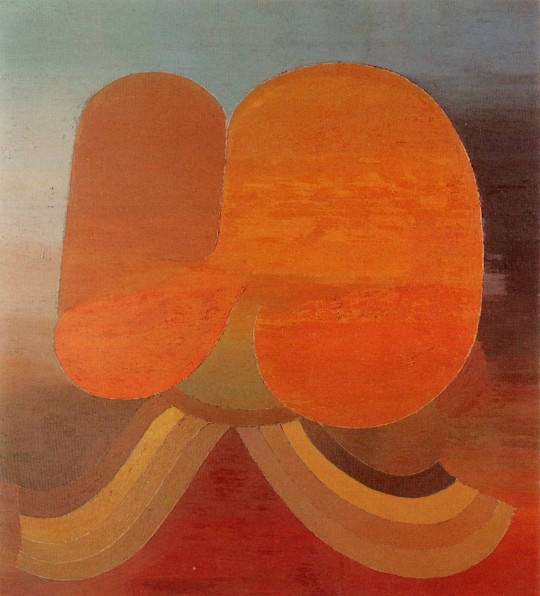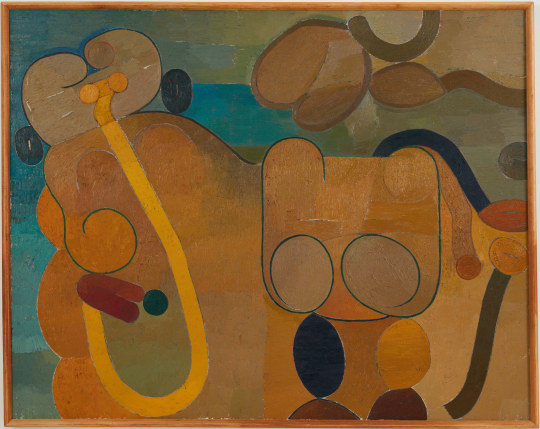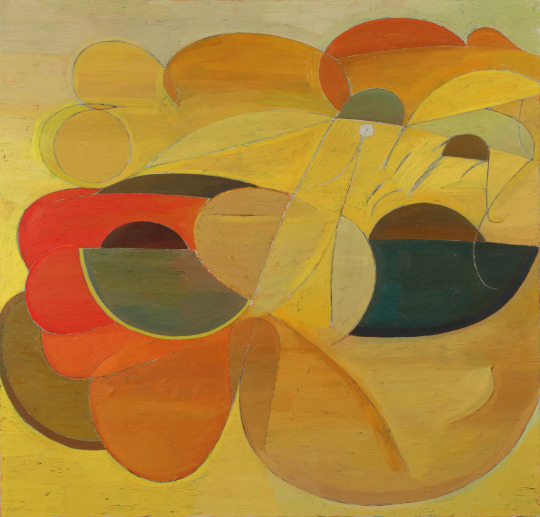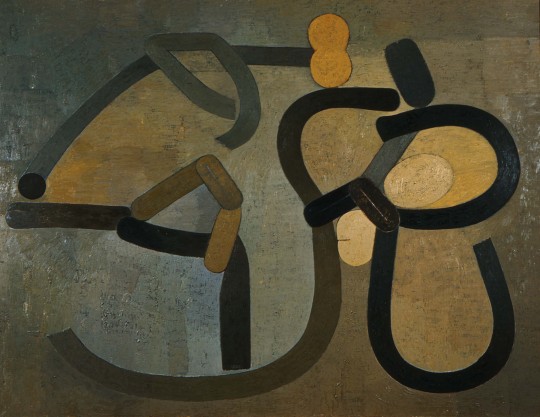#allusive abstractionists
Explore tagged Tumblr posts
Text

Miyoko Ito, "Untitled Landscape," c. 1957,
Oil on canvas,
38¼ h × 49 w in (97 × 124 cm)
Allusive Abstractionists"
#abstract#art#abstraction#painting#forms#abstractart#landscape#miyoko ito#1957#abstractionism#allusive abstractionists
47 notes
·
View notes
Text







Miyoko Ito 1918–1983
Allusive abstractionist Miyoko Ito was born into a Japanese family in Berkeley, California in 1918. She moved to Japan with her parents in 1923 to avoid discrimination and for initial art training, including calligraphy lessons. Ito later returned to Berkeley and majored in art at the University of California, where she was exposed to Cubist works by Pablo Picasso and Georges Braque plus Hans Hofmann's geometric compositions. During World War II, Ito was interned with her family at the Topaz camp in Delta, Utah, but she was awarded her diploma from UC Berkeley in 1942. After graduate study at Smith College in Northampton, Massachusetts, Ito earned a scholarship for postgraduate work at the School of the Art Institute of Chicago.
In the late 1940s, Ito began to paint abstract oils in a Cubist style softened with Impressionistic brushwork. Critical acclaim came in the 1950s as Ito's paintings were part of the Art Institute's Chicago and Vicinity shows as well as the 61st American Exhibition in 1954. During this period, Ito befriended local artists Ray Yoshida and Evelyn Statsinger, whose passion for Surrealism led Ito to move away from representational painting. Rather than render landscapes, figures, or objects explicitly, Ito suggested them with shapes, lines, and curves. Simultaneously, Ito's preferred palette went from pastels to vivid oranges and reds, which she banded subtly to compel attention.
Although free of Pop references, the work that Ito made in the 1960s has been linked tangentially to Chicago Imagism, and Ito knew Jim Nutt, Gladys Nilsson, and Roger Brown. Blues, greens, and purples returned to Ito's painting in the 1970s before she grew more formally abstract as the 1980s began. With the artists Richard Loving, William Conger, and Frank Piatek, Ito devised the term 'allusive abstractionism' for their shared approach.
27 notes
·
View notes
Photo
Vicente Manansala
Vicente Silva Manansala (January 22, 1910 – August 22, 1981) was a Filipino cubist painter and illustrator. One of the first Abstractionists on the Philippine art scene, Manansala is also credited with bridging the gap between the city and the suburbs, between the rural and cosmopolitan ways of life. His paintings depict a nation in transition, an allusion to the new culture brought by the Americans.

Vicente Silva Manansala, Arm Wrestling, 1948
93 notes
·
View notes
Photo

Recombination 1. Crack. The rumble of an approaching reality sounds. In this photo there is no object, here an action is fixed, something that was static acquire the time scale before and after. This photo opens a series of Recombinations. The main problem is the fixation of energy release or the identification of potential energy, the release of which will be in the future. The image of the damaged surface is an allusion to the cut canvases of the Italian abstractionist Lucio Fontana, his works form the concept of space in the two-dimensionality of the pictorial canvas. The picture becomes voluminous, three-dimensional, the immanent autonomy of the flat surface of the picture disappears. Consideration of cracks on the walls in the context of the creative method of the artist Fontana becomes natural and even necessary, the wall becomes a living organism, accidentally throwing out its own “breath”, the walls breathe. The material acquires transcendence, depth, sound, in the aggregate a message is revealed, spoken by time and the pattern of internal processes, a crack on the wall is inevitable, as the inevitability of withering, aging, death, transformation, transition to a new quality is evident. The crack becomes the result of a recombination of materiality, striving for an endless renewal. Time acts on the wall destructively, but destruction is also creation power at the same time.
#recombination1#crack#contemporaryart#allusiontofontana#transformation#recombinationblog#circlesofattention
0 notes
Text
Hyperallergic: Merrill Wagner’s Puzzles in Color and Tape
Merrill Wagner, “Each Day” (1978), oil on linen, 6 x 12 feet (all images via galeriezurcher.com)
Merrill Wagner’s remarkable tape paintings are as much head games as they are inquiries into precision and chance. Trying to puzzle them out is akin to reverse-engineering a ship in a bottle: even after you know the technique, you still can’t quite imagine what it took to pull it off.
The exhibition Merrill Wagner: Works from the 70’s at Zürcher Gallery is a follow-up of sorts to last year’s 1970’s: 9 Women and Abstraction at the same venue, which featured eight of Wagner’s tape pieces. In the current show, five are on display in the main gallery (a number of small ones are hanging in the back office), including one two-part and one four-part work , along with several paintings using conventional materials. A lone three-dimensional work, “Alizarin Crimson Corner Piece” (1974), is an oil-on-canvas painting/sculpture inserted into a corner on the floor.
Several of the paintings executed in oil or acrylic are from the 1960s, despite the exhibition’s title. The earliest, an untitled 20-by-24-inch canvas from 1961, is crowded with brushy, cloud-like forms in warm tones of gray, off-white, and black. Two others, also untitled, are hard-edged monochromatic abstractions from 1965 and ’67 in shades of blue and gray, respectively.
These are handsome exercises in the idiom of their day, but the most impressive, and inventive, work seems to break out, fully formed, in 1978 — the year that produced all of the tape pieces in the main gallery space as well as the epic oil-on-linen “Each Day,” measuring 6 by 12 feet.
“Each Day” was made with tape, but in the customary way — laid down, painted over, pulled off. There are two departures from business as usual, however: the exactitude with which the intervals of tape were fixed to the unprimed canvas, and the brushy, organic, almost gestural application of paint.
The composition, if you want to call it that — it should really be characterized as a system or pattern — is a series of vertical stripes, alternately painted and unpainted, of matching widths, though the painted ones fluctuate slightly, creeping over the borders determined by the masking tape, presumably from the scrubbing-on of the color, which occasionally slips beneath or dislodges the tape’s edge.
Although it seems to have been conceived with Minimalist precepts in mind, the effect is a paradoxical sensation of austere, shimmering lushness. The only consistent color is the ecru of the raw canvas, while the painted verticals — all of them a metallic gray — shift in tonality as they move from left to right, with hints of pink, green, violet, and blue.
One of the more beguiling aspects of the painting is that the stripes appear to be layered, with a primary coat of Mars red or some other warm, earthy color beneath the gray, but close attention reveals that the reddish tones gracing the edges of the stripes are dark bits of gray pigment clinging to the tooth of the canvas. I doubt that you will come across another painting anytime soon that is as simultaneously measured, stark, and ravishing.
In the catalogue for Wagner’s compact retrospective at the New York Studio School (November 21, 2016 – January 8, 2017), Tiffany Bell, in a brief account of the artist’s early life and training at the Art Students League in New York (under the unlikely trinity of the moody realist Edwin Dickinson, the German expressionist George Grosz, and the landscape-abstractionist Julian Levi), writes:
The paintings Wagner began to make within two years of leaving art school were large abstracted landscapes in geometric forms. They were an attempt to reconcile an affinity for nature acquired while growing up near the vast wilderness of the American West with her present urban environment. She used techniques learned in art school and adapted them to her interest in the then dominant tendency in New York painting toward abstraction. […] By the late 1960s, her work became less referential and more involved with materials.
Bell’s balancing of the terms “abstraction” and “materials” is significant — especially with regard to the works from 1978 that are on display here — by differentiating their absolute thingness from the allusions to the observational world that you find even in something as densely materialist as Richard Serra’s black oil-stick drawings. “Each Day” is less an abstract painting than a striped object made of oil paint, raw linen, and wooden stretchers.
This may sound like a slippery, even specious distinction, but I think it’s essential to piecing together the blunt authority of the tape paintings — objects made from unapologetically non-art materials (a practice she has continued with experiments in steel, slate, Rust-Oleum, stone, and cement-block walls, among other supports and mediums) with plainspoken directness.
Merrill Wagner, “Untitled” (1978), Permacel tape and oil pastel on Plexiglas, 6 x 12 inches
The look of these works is inseparable from the way they were made, which could nudge them under the umbrella of process art, but that doesn’t sit well either — there isn’t an indication that ongoing change is embedded in their aesthetic, at least in a noteworthy way. Rather, they manifest a kind of fluidity within stasis, in which factors such as surface irregularities and hand pressure take the place of a deliberative compositional strategy.
Wagner’s method is as straightforward as it is mind-bogglingly precise, so much so that it took a great deal of close scrutiny to fully grasp exactly what she is doing.
Although her approach may vary in other tape works, the ones hanging in Zürcher’s two main rooms begin with strips of tape laid down in the center of a sheet of Plexiglas, creating a shape that approximates a square. The tape strips meticulously abut one another, edge to edge, forming a solid surface, which is then covered in a single color — yellow, purple, red, or black — of oil pastel. Wagner then applies a second, perpendicular layer of tape over the colored strips, again precisely edge to edge.
This is where the process seems to bridge the impossible: once the second layer is complete, the artist pulls the tape off, now mottled with accidental infusions of color on its adhesive side, and lays it down on its own piece of Plexiglas, often joining the two sheets as components of a single work. The skill involved is astonishing, given tape’s tendency to curl, wrinkle, crease, and otherwise misbehave. The only deviation from perfection, which allows an insight into the assembly process, is that the edges of the block of color on the adhesive side are slightly off-register from one band of tape to the next.
Merrill Wagner, “Untitled” (1978), tape and oil pastel on Plexiglas, each panel: 49 x 48.5 inches
A ’78 untitled diptych in golden yellow is easily the juiciest piece in the show. The right half is oil pastel over narrow, vertical strips of what could be drafting tape, while the left is composed of broader bands of horizontally aligned tape facing us from the obverse side of the Plexiglas. The vertical striations on the right, which include unaccountable stains of brown, are transferred to the adhesive side of the tape on the left, but the original surface now bears slight traces of the left half’s horizontal edges: each iteration affects the other.
This co-dependency is brought to the fore in the smallest work in the main exhibition space, another untitled piece from 1978, in which, on a rectangular sheet of Plexiglas twice as wide as it is tall (6 by 12 inches), Wagner lays down a vertical set of tape strips in the shape of a square on the left, while its horizontal, mirrored impression shows through the clear recto on the right.
Again, the skill level is extraordinary, but it is also worth reflecting on the radicalness of making art out of such a basic but seemingly unworkable premise. To turn tape into the main medium instead of a temporary tool is on its face a counterintuitive idea, but its roots in the mechanics of Modernist painting technique endow it with a legitimacy that we don’t even think to question. And that, if you like, is a form of wizardry, as much as achieving a lustrous, luxuriant sensuality out of materials as industrial and recalcitrant as Plexiglas and tape.
Merrill Wagner: Works from the 70’s continues at Zürcher Gallery (33 Bleecker Street, Bowery, Manhattan) through June 24.
The post Merrill Wagner’s Puzzles in Color and Tape appeared first on Hyperallergic.
from Hyperallergic http://ift.tt/2se3jKr via IFTTT
0 notes